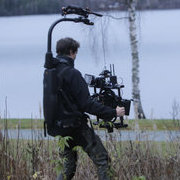Search the Community
Showing results for tags 'ISO'.
-
I’ve recently started to incorporate using iso to better take advantage of exposing my scenes to maximize dynamic range in either the highlights, shadows or a mix depending on what I’m filming. For example, if I’m filming daytime exteriors I’ll typically kick up my iso to around 1000 and ND down to reign in my exposure and retain better dynamic range in the highlights or if I’m filming a scene with shadows I’ll lower my iso and light the scene bring my exposure to here I want it and retain better (and lower noise) shadow detail. I think that I mostly understand why I should be doing this but I’ve recently started thinking about my first example—daytime exteriors—and need some help understanding how it works. My issue is that while I bring up my iso (also increasing the noise floor) I’m still having to ND to expose properly and am thus cutting off the amount of light hitting the sensor. Shouldn’t this cause issues with sensor noise, more than say if I kept my iso lower and used less ND, obviously this would not bias my DR towards the highlights like it would if I used a higher iso. Thoughts appreciated, thanks!
- 1 reply
-
- iso
- dynamic range
-
(and 5 more)
Tagged with:
-
I have read ARRI's whitepaper on dynamic range and how the EI is used to assign which signal value we want to choose as middle grey, which ultimately allows us to control the exposure latitude around middle grey. I've also read that the way ARRI does this is by only allowing us to shoot at its native ISO 800 (or maybe as some say its 400) and that changing the EI is like adding an exposure LUT on our image. This would make sense to me, because it would explain how the dynamic range (SNR=1 to full well capacity) is able to stay constant at different EI, because it doesn't operate by increasing the gain of the signal. (It would also explain why its they use the nomenclature EI) Nevertheless, I would like to know how they do this and if what I have read is correct?
-
- exposure index
- iso
-
(and 3 more)
Tagged with:
-
Hi, I am posting here for the first time, so little bit nervous. The topic might not be properly linked to aesthetics or techniques of Cinematography . Kindly let me know if this is not suitable subject (or has been discussed before). I was trying to dive into the term ‘ISO Invariance’ and I came across some videos and articles (linked below) which confused me even more. My understanding(might be incorrect) is that the voltage at pixel level ,when the photosite gets exposed to light, is very low and the Analog value is amplified by some factors then sent to the ADC,followed by De-Bayering, Chroma Subsampling etc. The gain of the voltage here should be linked to ISO we set and the factor will differ as we play around. Now for the RAW data we do have control in post to change the ISO , which implies that ISO is not a deciding factor like Color Temperature and not mapped on the footage.However, in the videos and articles I see that the tests are showing Photographic Cameras are not totally ISO invariant and they are introducing noise when set to higher ISO. Unfortunately I don’t own a high end Cinema Camera to test this and didn’t find anything related , so my question is : are cinema cameras really ISO invariant? If yes, should we care about setting up proper ISO on set ? If no, what’s the point of having an external control in post to modify it? https://photographylife.com/iso-invariance-explained Thanks in advance. ?
-
Hey, I was reading through Kodak's 'The Essential Reference Guide for Filmmakers' and came across the following: A word about film speeds You probably know that motion picture films use exposure index (EI) to indicate speed. Although similar, EI is not the same as the ASA or ISO speed used for still films. EI denotes a somewhat conservative figure related to the higher quality requirements of motion picture film that must be projected onto a large screen. Typically the EI speed is about one stop lower than ASA or ISO. EI 500 film, therefore, is the equivalent of ASA/ISO 1000. Is anyone able to develop further on this? It is the first time I've come across the concept that EI is not the same as ISO. If I take what is written literally, does this mean that I should be setting my light meter to read at 500 instead of 250 (assuming I am shooting on say 250D stock) to get correct exposure? All the best, Connor
- 13 replies
-
- Kodak
- Exposure Index
-
(and 3 more)
Tagged with:
-
Hello everyone, As I consider buying my first light meter and delve deeper into the world of cinematography, there are a few questions I can't seem to find (satisfying) answers for, at least online. I'd really appreciate any help in these matters. Question 1 Why is it so important to define a camera's true native ISO. Not the marketed one but the actual real one. I've learned how to do it it but I still don't understand why I'd do it. As an example (hypothetical), let's say I'm using an Alexa and I come to the conclusion that its real ISO is 400 instead of the proclaimed 800. What am I supposed to do with that? Should I question the way the stops are supposedly distributed between shadows and highlights? Supposedly at ISO800 it's -7/+7 stops of range, did that range now move to 400? Like what's happening here? Also, does it differ from camera to camera, even if it's the same model? Or can I trust the results from tests done from people I know I trust; whether online or otherwise, for that specific model? I understand we must test, test and test. As a novice I can assure you this notion is drilled into our minds by almost every self respecting cinematographer, gaffer, DIT etc. And I am thankful for it. However can't we trust these manufacturers at least a little bit? Question 2 I took a cinematography workshop not too long ago, my first, and was introduced to light meters and how useful they are. Now that I'm about to work on my first couple of projects I can't imagine myself not using one. However. During that workshop several people had the same light meter (mostly Sekonic 858) and, surprise, not all readings were the same. From the same position on the same spot, whether reading incident light or spotting, people were getting (slightly to not-so-slightly) different readings. So here's my question, how can I tell if I can trust my light meter? I live in a country where most people don't use light meters and we don't have any kind of support to send them off to calibration. Any suggestions? In case it's essential to make sure that the light meter is reading accurately, does anyone know of someone or of a service center that does this anywhere not in the Americas? Also, has anyone ever dealt with Sekonic's service center, the one in Oman? Many thanks. Don't judge me too harshly on my trust issues :)
-
I was reading the Oscillating the ISO on Alexa thread yesterday and in it David says so I was wondering is there an easy way do to a calculation of this sort on the spot without any aid from a gadget or an exposure calculator: What is the difference in exposure between ƒ/4.5, 24 fps, ISO 640 and ƒ/2.8, 60 fps, ISO 800?
-
Hi guys! After some research, I made a little chart one every rich man's favorite camera, the Alexa, which digs into how it really works. So I thought I might as well share it. The content holds true for every Alexa I believe, since they all have pretty much the same sensors and algorithms (even the Alexa 65 I assume, who consists of three Alexa sensors merged). On the right of the table are the only available curves to my knowledge, the LogC ones. Every other curves isn't, but should be available, so here they are. Where did I find this stuff ? A combination of gathering bits of informations here and there, and the ability to think like an Arri R&D guy I guess (they always seem to make the most logical choices in sensor architecture). CLICK and enjoy for zoomable chart.
- 141 replies
-
I've been researching the native ISO of RED cameras (primarily the Dragon and MX). What's been confusing isn't the notion of a native ISO, but rather that in the debate between 320 and 800, people are referring to shooting at ISO 800 as underexposing when compared to ISO 320. From one such individual: "At 320 (which may be closer to the sensors "native" sensitivity- or the point where the raw matches the redcolor as far as middle grey) you have much less range in the highlights. By rating 800, you are underexposing the sensor a bit and protecting the highlights." Bear with me as I'm more of a lighting guy, but my question is: how is it that by increasing ISO by 1⅓ stops are you underexposing the sensor? What am I missing? Thanks so much for your help!
-
I just watched this video and tought about the story on Kubrick and the candlelit scenes on "Barry Lyndon". What would he be doing with today's cameras and lenses? Of course cinematographers aren't using f0.7 lenses on day to day basis but, for example, Master Primes and Cooke 5 are pretty bright and camera ISO technology are advancing everyday. With a camera capable of a base ISO 5000 and a Master Prime on T1.3 candlelit scenes would be just the start on the cinematography crative process. What do you think?
-
I recently purchased a reloadable super-8 cartridge from Wittner and I'm extremely confused about where to cut the ASA notch. I bought the CHROME 200D film which is Daylight: 200 and Tungsten: 50. Please could someone tell me where to cut the notches for this stock? Or somewhere said something about not needing notches for daylight film? Im very confused. I have been trying to use this guide: http://peaceman.de.www127.your-server.de/schmalfilm/super8/S8_Notch_Tools_v1.0.pdf But I'm struggling. Please could someone tell which notch to cut to on this guide? Thank you! -Harry
-
Hi. I shooting a little narrative film on the Arri Alexa camera. We don´t have the time to shoot a test before we start shooting and I watched some test online about how high you can go with the ISO in the camera in low light locations. Do anyone in here have good experience with the Alexa camera? And how high can I put the cameras ISO with out seeing to much noise in the blacks? Thanks, Henrik www.henrikameyer.com
- 6 replies
-
- Arri Alexa
- low light
-
(and 4 more)
Tagged with:







